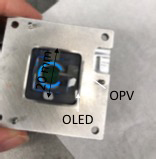 Scientists from Kiel University (CAU) have investigated the possibility of using organic optoelectronics in the field of measurement technology. The goal is to integrate OLEDs and OPVs on a chip for the development of future lab-on-chip system for fluorescence detection. In a first proof-of-principle experiment, organic light-emitting diodes and organic solar cells in various designs were realized on a substrate in the clean room of the Kieler Nanolabor and initial fluorescence measurements were carried out. These results were presented in a lecture at the XXXI. Messtechnisches Symposium des Arbeitskreises der Hochschullehrer für Messtechnik (S. Jahns, J. Balke, A.F. Iwers, M. Gerken: Organic optoelectronics for lab-on-chip fluorescence detection, Proceedings AHMT 2017).
Scientists from Kiel University (CAU) have investigated the possibility of using organic optoelectronics in the field of measurement technology. The goal is to integrate OLEDs and OPVs on a chip for the development of future lab-on-chip system for fluorescence detection. In a first proof-of-principle experiment, organic light-emitting diodes and organic solar cells in various designs were realized on a substrate in the clean room of the Kieler Nanolabor and initial fluorescence measurements were carried out. These results were presented in a lecture at the XXXI. Messtechnisches Symposium des Arbeitskreises der Hochschullehrer für Messtechnik (S. Jahns, J. Balke, A.F. Iwers, M. Gerken: Organic optoelectronics for lab-on-chip fluorescence detection, Proceedings AHMT 2017).
Organic optoelectronics in fluorescence measurement technology

